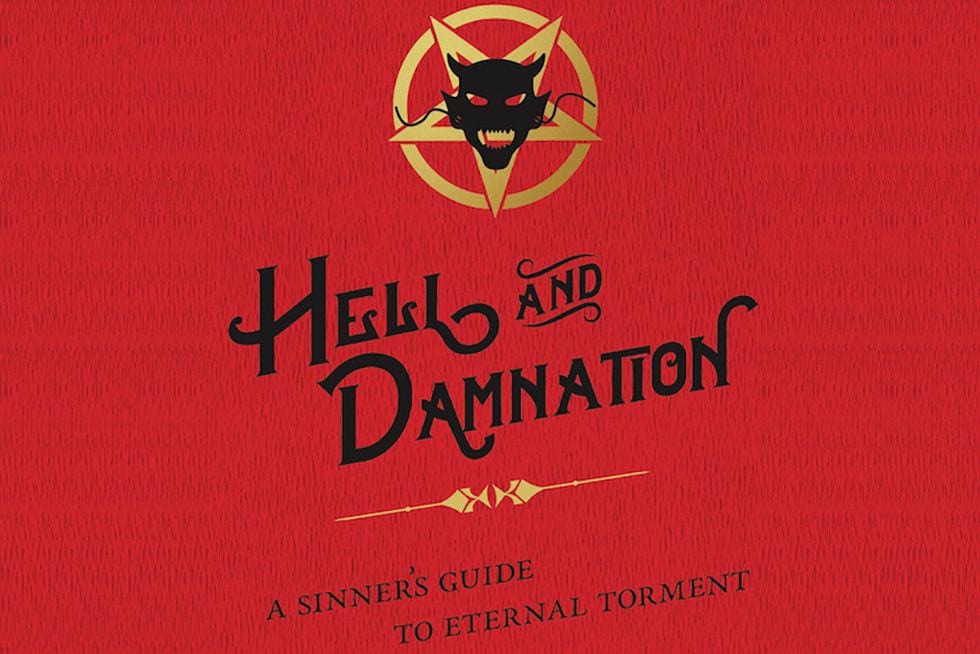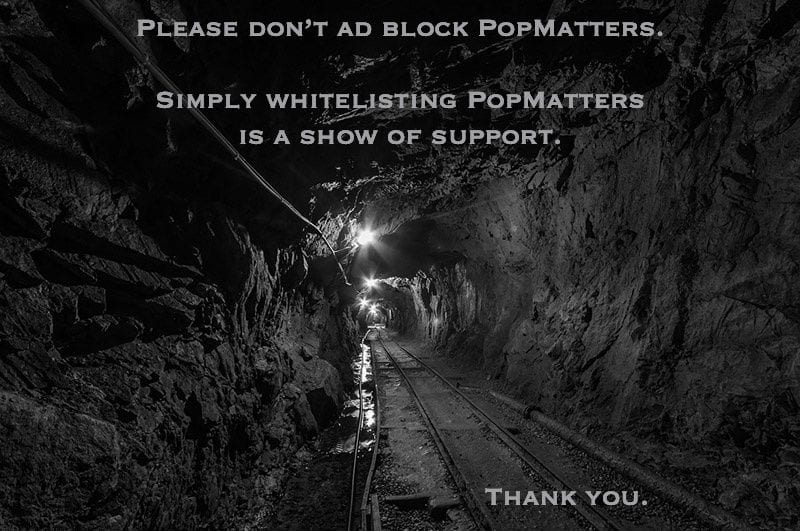
In his Inferno, medieval Italian poet Dante undertakes hell’s grand tour, guided by the spirit of Roman poet Virgil who, in his own epic, The Aeneid, mapped out Hades. Now, playing Virgil to us all, Marq De Villiers surveys hell, Hades, and their connections, along with other sundry underworlds, in his book, Hell and Damnation: A Sinner’s Guide to Eternal Torment. De Villiers, author of over a dozen books on an array of real places, including post-Perestroika Russia, Revolutionary War-era America, and ancient Africa, appears to take satanic pride in, like a demonic Belinda Carlisle, making hell feel like a place on Earth.
Unlike Virgil, however, De Villiers has a sense of humor. With its droll title and effulgent gold and red with a pentagrammed smirking demon, this is, in fact, a good book to judge by its cover—and the idea of judgment will soon prove crucial. Then, with its dedication “to skeptics everywhere”, and first epigraph, “Eternity is a very long time, especially towards the end,” by Woody Allen, readers will already discern where, aside from abysses, this book is headed: someplace unexpectedly fun.
“I didn’t go into it necessarily saying, there is humor in here,” De Villiers said in an interview I conducted with him. “But when you delve into the multifarious and conflicting conceptions of what the afterlife is like, and then you start to examine them under that prism, the behavior of the gods involved, including very much the Old Testament Jehovah, who seems conflicted as to whether he needed to punish a fallen angel, or he needed a place to punish sinners, there is no consensus as to what the purpose of the whole thing was. And then you come upon some aspects of what Jehovah got up to, and you think, you know, really, this is not good politics on his part. If you think of God as someone angry, who hadn’t really thought through what he was doing, you can’t help but treat it in a lighthearted manner.”
Skipping from the book’s front to the back, a reader can also judge this book by its index: opening with “Aboriginal Australians” and ending on “Zoroastrianism, De Villiers has boldly decided on the completist’s approach to damnation. In between, he takes readers not just to hell and back, but to, among many other places, the Norse single-“l” Hel, meaning “the covered hall”; the “eighty and counting hells” of Hinduism, where reincarnation may, as the book reports, be “thousands or perhaps millions of years” away; and “the ever-proliferating hells of Buddhism”, which some Westerners associate with Nirvana without knowing the possible cycles the soul must endure before getting there, including, among many others, “the hell of Pulling Tongues”, “the hell of Dung and Urine”, “the hell of Fire Elephants, the hell of Fire Dogs, the hell of Fire Horses”, or “the hell of Flaying Skin and the hell of Drinking Blood”, as enumerated not by a Slayer track listing but in The Sutra of the Past Vows of Earth Store Bodhisattva, which De Villiers’s book quotes at length.
I asked De Villiers what made him attempt such a comprehensive guide. He explained, in an anecdote that didn’t make it into the book, that Galileo himself decided to figure out “how far down hell must be—this famous astronomer, working backward from Dante’s presumed position of Satan’s navel, calculated hell must be about 650 kilometers beneath the surface of the earth.”
“This is not,” De Villiers deadpanned, “one of Galileo’s signature achievements, obviously.”
Further, he explained, it was not one of the many violent hells that got him reassessing the subject, but rather one of the versions of Buddhist hell that “had nothing to do with torture, but was essentially a large waiting room where sinners would sit, basically forever, trying to get the attention of the a bureaucrat and never doing so. That is a terrible hell.” It was the accumulation of “all these odd facts” that set De Villiers on his road to perdition.
But rather than settling for Norse, Greco-Roman, and Ancient Egyptian underworlds—mythologies with no contemporary practitioners—De Villiers takes pains to include Christianity, Islam, and Judaism. “Virtually every human society had some version of hell afterlife, with some more dire than others,” he said. “Some of the ancient Egyptian version of the afterlife that did get into torment were adopted by the Coptic Christians, but it was the Christians who introduced this notion of eternality, forever. There is a wide range of human conception.”
In Hell and Damnation, it seems possible to interpret diverse cultures’ conceptions of hell in opposite ways. On the one hand, we learn disparate hells’ shared traits: they are underground, dark, and frequently gated; there is often (although not always) someone, usually (although not always) a male authoritarian in charge; and they confer torment, if not forever, than for a very long time, with a penchant ironic punishments that long predate Dante’s Inferno. On the other hand, different groups’ hells also seem culturally specific: no hell at all in ancient Africa; Sheol, a dull but thankfully torment-free waiting room for souls in versions of Judaism, and something, coincidently, similar in Shinto, the traditional religion of Japan; Norse Hel was for regular, boring people, with Valhalla reserved for warriors; and the many “inquisitive Christians”, including Dante, whose poetic cautionary tales “grew grimmer, and the devil grew ever larger, ever blacker, ever more grotesque, ever more horrific” with each century’s retellings and revisions. Hell, as a cultural production, has elements that are both universal as well as adapted to specific belief systems.
From that cover onward, De Villiers clearly sees hell as a human, not divine, invention, before finally explicitly stating so at the end of the last section before the epilogue: “Perhaps it would be a more interesting and magical world if Ereshkigal and Baal and Ishtar and Yama and Hades were real (though Satan not so much, nor Baal’s unruly sister)—but alas, they’re not. Except in the human imagination, where they belong.” The epilogue that follows, then, is arguably the most important part of the book, since, rather than describe hell and the devil, it finally ventures into their philosophical and moral implications and the question of theodicy.
De Villiers is clear about who invented hell—humans did, at the particular cultural moment when monotheism proffered a single, omnipotent being, and at the same time, society had grown sufficiently large to require hell as a form of social control. Religion, then, culturally evolved to induce people to behave without direct human enforcement. Hell may be bad, but it is useful, and its existence can even comfort. As De Villiers writes, “There must be a hell in order to balance life here on earth and to consign malefactors to their just desserts.” People feel reassurance, not just fear, from hell, since its existence, and the punishment of sinners and reward for the virtuous would provide the cosmic justice that is impossible to guarantee on earth.
Yet at the same time, De Villiers’s conclusion suggests that, while hell has provided a certain measure of certainty, he laments that this kind of social coercion has, until recently, caused more cruelty than justice. Thankfully, then, “jurisprudence hasn’t invoked the supernatural since the last witches went to the stake.” Perhaps, though, De Villiers is being too optimistic—although, as he notes earlier, “hell is hanging on.” But also, in a strange twist on such an inclusive study, perhaps the book is too restrictive or ends too soon.
The one aspect of hell and the devil that this otherwise far-reaching book leaves out is, for me, the most contemporarily significant: hell as a metaphor—and often as a corrective symbol of empowerment, not evil. The book leaves off with Milton’s Paradise Lost, from 1663, which, as scholars have noted for centuries, depicts Satan not as a tormentor (there are no humans in hell yet in Milton’s telling) but as a revolutionary, proto-Romantic hero, a proud underdog waging an unwinnable war against the dull, omnipotent tyrant in Heaven. Milton’s Satan realizes that he can’t beat God, so he finally strikes a blow by tempting God’s new favorites, Adam and Eve, into disobedience and resultant banishment from Eden. Yes, for Milton the fall is a felix culpa, because without it there could be no Christian redemption, but to many readers, including Romantic poets William Blake and Percy Shelley, the ironic achievement of Paradise Lost, as Blake and Shelley’s cultural successor Mick Jagger would sing centuries later, is in building sympathy for the devil.
Today, we live in the age of antiheroes that hell, and Milton, inadvertently ushered in. Blues legend Howlin’ Wolf, rock gods Jim Morrison and Ozzy Osbourne, and Goth-metal band Ghost—to say nothing of fans of pop culture characters like Hellboy, videogame sensation Undertale (GameMaker Studio, 2015) the television show Lucifer (Fox, 2016- ) and nearly every creation by Neil Gaiman—understood the devil as an rousing spirit of rebellion, with wickedly cool iconography. Meanwhile, other writers, famously Jean Paul Sartre in his play No Exit and, less famously but just as brilliantly, Gloria Naylor in her 1985 novel, Linden Hills(Penguin), use hell as a different, darker narrative device: that there is no theological version of hell that is arguably worse than what humans are capable of doing to each other right here on Earth. Hell is a place on Earth, because Earth is, metaphorically, already a place like hell.
“Maybe,” De Villiers said, when I raised these concerns, “there will be a Volume II, because I did stop with Milton.”
In the 21 st century, the cover of the book, as we all implicitly understand, is not a warning: it’s an enticement. The devil has always been seductive, but, for readers of Hell and Damnation, he serves as a welcome distraction from contemporary life, which too often resembles the thousands of Chinese Buddhist hells, each seemingly “more pedantic, ever more bureaucratic, ever more frustrating.” The joy of this book may be in De Villiers’s depictions of hells, which, for anyone not worried about actually going there, seem less like warnings and more like celebrations of the human imagination. As De Villiers told me, “I think imaginations of the afterworld of hell, and also of heaven, are coming out of humanity’s deep psyche.”
Still, was there some additional motive behind such a project? I had to ask: De Villiers’s name has the word “devil” hidden in it. Was that, somehow, unconsciously, some kind of motivation for the subject?
“No, that was pretty coincidental.”
Finally, a definitive answer.



![Call for Papers: All Things Reconsidered [MUSIC] May-August 2024](https://www.popmatters.com/wp-content/uploads/2024/04/all-things-reconsidered-call-music-may-2024-720x380.jpg)



